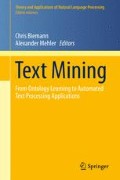Abstract
Ontologies have been used in different important applications like information extraction, generation of grammars, query expansion for information retrieval etc. However, building comprehensive ontologies is a time consuming process. On the other hand, building a full-fledged ontology is not necessary for every application which requires modeling of semantic classes and relations between them. In this chapter we propose an alternative solution: learning a textology, that is, a graph of word clusters connected by co-occurrence relations. We used the properties of the graph for the generation of grammars and also suggest a procedure for upgrading the model into an ontology. Preliminary experiments show encouraging results.
Access this chapter
Tax calculation will be finalised at checkout
Purchases are for personal use only
References
Bollegala D, Matsuo Y, Ishizuka M (2008) A co-occurrence graph-based approach for personal name alias extraction from anchor texts. In: International joint conference on natural language processing (Ijcnlp), pp 865–870
Bordag S, Heyer G, Quasthoff U (2003) Small worlds of concepts and other principles of semantic search. In: Böhme T, Heyer G, Unger H (eds) Iics, vol 2877. Springer, New York, pp 10–19. Retrieved from http://dblp.uni-trier.de/db/conf/iics/iics2003.html#BordagHQ03
Buitelaar P, Cimiano P (eds) (2008) Ontology learning and population. Bridging the gap between text and knowledge. Springer, Berlin
Carlson A, Betteridge J, Kisiel B, Settles B, Estevam R, Hruschka J, Mitchell T (2010) Toward an architecture for never-ending language learning. In: Proceedings of the twenty-fourth AAAI conference on Artificial Intelligence (AAAI-10), Atlanta, GA, pp 1306–1313
Costa ME, Bonomo F, Sigman M (2009) Scale-invariant transition probabilities in free word association trajectories. Front Integr Neurosci 3:17
Dagan I, Glickman O, Magnini B (2006) The pascal recognising textual entailment challenge. In: Machine learning challenges. Evaluating predictive uncertainty, visual object classification, and recognising tectual entailment. Springer, New York, pp 177–190
Drumond L, Girardi G (2008) A survey of ontology learning procedures. In: The 3rd workshop on ontologies and their applications, Salvador, Brasil, pp 13–25
Feldman R, Sanger J (2007) The text mining handbook. Advanced approaches in analyzing unstructured data. Cambridge University Press, Cambridge
Heyer G, Läuter M, Quasthoff U, Wittig T Wolff C (2001) Learning relations using collocations. In: Maedche A, Staab S, Nedellec C, Hovy EH (eds) Workshop on ontology learning, vol 38. CEUR-WS.org. Retrieved from http://dblp.uni-trier.de/db/conf/ijcai/ijcai2001ol.html#HeyerLQWW01
Klebanov BB, Flor M (2013, August). Word association profiles and their use for automated scoring of essays. In: Proceedings of the annual meeting of the association for computational linguistics, Sofia, Bulgaria
Matsuo Y, Ishizuka M (2004) Keyword extraction from a single document using word co-occurrence statistical information. Int J Artif Intell Tools 13(01):157–169
Navigli R, Velardi P (2008) From glossaries to ontologies: extracting semantic structure from textual definitions. In: Ontology learning and population. Bridging the gap between text and knowledge. Springer, Berlin, pp 71–87
Ohsawa Y, Soma H, Matsuo Y, Matsumura N, Usui M (2002) Featuring web communities based on word co-occurrence structure of communications: 736. In: Proceedings of the 11th international conference on world wide web, p 742
Pantel P, Lin D (2002) Discovering word senses from text. In: Proceedings of ACM SIGKDD conference on knowledge discovery and data mining, Edmonton, pp 613–619
Riloff E, Jones R (2002) Learning dictionaries for information extraction by multi-level bootstrapping. In: Proceedings of the sixteenth national conference on Artificial Intelligence (AAAI 99), Orlando, FL, pp 474–479
Tanev H, Zavarella V, Kabadjov M, Piskorski J, Atkinson M, Steinberger R (2009) Exploiting machine learning techniques to build an event extraction system for Portuguese and Spanish. Linguamatica 2:55–66
Völker J, Haase, P Hitzler P (2008) Learning expressive ontologies. In: Proceedings of the 2008 conference on ontology learning and population: bridging the gap between text and knowledge. IOS Press, Amsterdam, pp 45–69
Wikipedia: Cyc. (2014) Retrieved from http://en.wikipedia.org/wiki/Cyc
Zortea M, Menegola B, Villavicencio A, Salles JFD (2014) Graph analysis of semantic word association among children, adults, and the elderly. Psicologia: Reflexão e Crítica 27(1):90–99
Author information
Authors and Affiliations
Corresponding author
Editor information
Editors and Affiliations
Rights and permissions
Copyright information
© 2014 Springer International Publishing Switzerland
About this chapter
Cite this chapter
Tanev, H. (2014). Learning Textologies: Networks of Linked Word Clusters. In: Biemann, C., Mehler, A. (eds) Text Mining. Theory and Applications of Natural Language Processing. Springer, Cham. https://doi.org/10.1007/978-3-319-12655-5_2
Download citation
DOI: https://doi.org/10.1007/978-3-319-12655-5_2
Published:
Publisher Name: Springer, Cham
Print ISBN: 978-3-319-12654-8
Online ISBN: 978-3-319-12655-5
eBook Packages: Computer ScienceComputer Science (R0)

